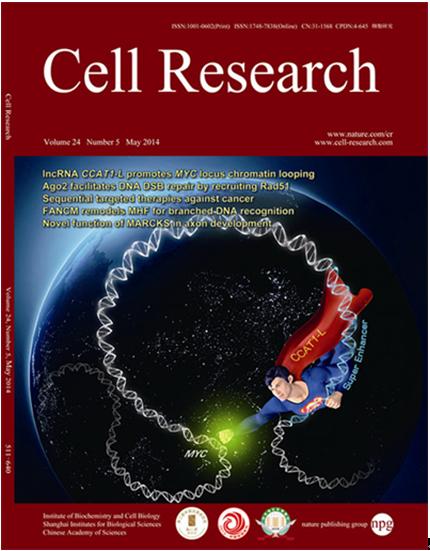
MYC Regulated by Super-Enhancer Long Noncoding RNA in Colorectal Cancer
May 19, 2014 Email"> PrintText Size

In cover story published on May 5th, 2014 in Cell Research, the team led by CHEN Lingling from the Institute of Biochemistry and Cell Biology, Chinese Academy of Sciences, presents a Colorectal Cancer (CRC) specific long noncoding RNA, CCAT1-L, in the regulation of MYC expression across over 500 kb in distance by participating in higher chromatin organization.
The expression of the human MYC oncogene is complex and regulated at multiple levels. One of the most mysterious regulations of MYC is that the megabase-sized region of human 8q24 gene desert around MYC contains many regulatory elements including enhancers and super-enhancers. These regulatory elements form looping interactions with MYC in a tissue-/tumor type-specific manner. However, how these chromatin loops in the MYC locus are regulated remains unknown.
Under supervision of Prof. CHEN Lingling, XIANG Jianfeng et al have identified a CRC specific long noncoding RNA, CCAT1-L, transcribed from 515k upstream of the MYC gene, a CRC specific super enhancer region. CCAT1-L accumulates to its sites of transcription, interacts with CTCF to facilitate the long-range chromatin interaction between distal enhancers and the MYC promoter. Knockdown of CCAT1-L decreases MYC expression by weakening the long-range interactions between the MYC promoter and its distal enhancers. In-cis activation of CCAT1-L with the TALEN technique minics endogenous CCAT1-L sub-cellular localization and function, upregulate MYC expression and promote tumorigenesis. This study leads to a better understanding of MYC regulation network and roles of lncRNAs in chromatin regulation.
This study entitled "Human colorectal cancer-specific CCAT1-L lncRNA regulates long-range chromatin interactions at the MYC locus" was published on Cell Research as a cover story and highlighted by S.T. Younger and Rinn with a title of "'Lnc' -ing enhancers to MYC regulation" on April 29th, 2014, Cell Research. This work was supported by grants from the Ministry of Science and Technology of China, the National Natural Science Foundation of China, and Chinese Academy of Sciences.

Human colorectal cancer-specific CCAT1-L lncRNA regulates long-range chromatin interactions at the MYC locus. (Cover story, Cell Research, 5, 2014)
In cover story published on May 5th, 2014 in Cell Research, the team led by CHEN Lingling from the Institute of Biochemistry and Cell Biology, Chinese Academy of Sciences, presents a Colorectal Cancer (CRC) specific long noncoding RNA, CCAT1-L, in the regulation of MYC expression across over 500 kb in distance by participating in higher chromatin organization.
The expression of the human MYC oncogene is complex and regulated at multiple levels. One of the most mysterious regulations of MYC is that the megabase-sized region of human 8q24 gene desert around MYC contains many regulatory elements including enhancers and super-enhancers. These regulatory elements form looping interactions with MYC in a tissue-/tumor type-specific manner. However, how these chromatin loops in the MYC locus are regulated remains unknown.
Under supervision of Prof. CHEN Lingling, XIANG Jianfeng et al have identified a CRC specific long noncoding RNA, CCAT1-L, transcribed from 515k upstream of the MYC gene, a CRC specific super enhancer region. CCAT1-L accumulates to its sites of transcription, interacts with CTCF to facilitate the long-range chromatin interaction between distal enhancers and the MYC promoter. Knockdown of CCAT1-L decreases MYC expression by weakening the long-range interactions between the MYC promoter and its distal enhancers. In-cis activation of CCAT1-L with the TALEN technique minics endogenous CCAT1-L sub-cellular localization and function, upregulate MYC expression and promote tumorigenesis. This study leads to a better understanding of MYC regulation network and roles of lncRNAs in chromatin regulation.
This study entitled "Human colorectal cancer-specific CCAT1-L lncRNA regulates long-range chromatin interactions at the MYC locus" was published on Cell Research as a cover story and highlighted by S.T. Younger and Rinn with a title of "'Lnc' -ing enhancers to MYC regulation" on April 29th, 2014, Cell Research. This work was supported by grants from the Ministry of Science and Technology of China, the National Natural Science Foundation of China, and Chinese Academy of Sciences.

Human colorectal cancer-specific CCAT1-L lncRNA regulates long-range chromatin interactions at the MYC locus. (Cover story, Cell Research, 5, 2014)
CAS Institutes
There are 124 Institutions directly under the CAS by the end of 2012, with 104 research institutes, five universities & supporting organizations, 12 management organizations that consist of the headquarters and branches, and three other units. Moreover, there are 25 legal entities affiliated and 22 CAS invested holding enterprisesThere are 124 I...>> more
Contact Us

Chinese Academy of Sciences
Add: 52 Sanlihe Rd., Xicheng District, Beijing, China
Postcode: 100864
Tel: 86-10-68597592 (day) 86-10-68597289 (night)
Fax: 86-10-68511095 (day) 86-10-68512458 (night)
E-mail: cas_en@cas.cn

